|
|
|
Sort Order |
|
|
|
Items / Page
|
|
|
|
|
|
|
| Srl | Item |
| 1 |
ID:
107548
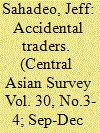

|
|
|
|
|
| Publication |
2011.
|
| Summary/Abstract |
Shrinking opportunities on the Soviet periphery pushed increasing numbers of Caucasus and Central Asian peoples to late twentieth-century Moscow. This article analyses the migration experiences of two Kyrgyz, one Uzbek and one Azeri who left their native villages, eventually engaging in private trade in Moscow's streets and markets. Using oral histories, the article reveals the importance and extent of trading networks across the Union of Soviet Socialist Republics, and the opportunities as well as perils that faced those who participated in this grey-market activity. Traders confronted complicated dynamics of inclusion and exclusion, and sometimes racism, from the host society. The migrant experience transformed ideas of identity and ethnicity, at home and away. As each realized economic goals, these traders also considered pursuit of social mobility, attracted by Moscow's dynamism. Strong family relationships and a tenuous sense of incorporation in the Soviet capital drove them home in the late 1980s.
|
|
|
|
|
|
|
|
|
|
|
|
|
|
|
|
| 2 |
ID:
007111
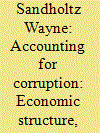

|
|
|
|
|
| Publication |
March 2000.
|
| Description |
31-50
|
|
|
|
|
|
|
|
|
|
|
|
|
|
|
|
| 3 |
ID:
166655
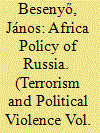

|
|
|
|
|
| Summary/Abstract |
We have heard ever more about the growing Russian presence in Africa in the past few years, which might appear strange for many people. Those, however, who know the history of the Black Continent, also know that Russian presence is not a new phenomenon. Africa was an important place during the Cold War where the Soviet Union not only competed with the United States of America, but also with China. For those who observed the robustly growing US and Chinese Africa policies, it could have appeared after the end of the classic Cold War, that the Russians had retreated beyond the borders of their country, abandoning the Black Continent in favour of their previous rivals. However, it did not happen, because the Russians did not close their diplomatic missions as they did in the former socialist countries of Eastern Europe. Furthermore, the Russians played a key role in UN Peacekeeping Missions in Africa, where they provided the necessary Air Transportation Capabilities together with the Ukrainians. Today it is becoming obvious that not only a new form of the Cold War has been resumed between the West and Russia but also the fact that the Russian “retreat” was only temporary. The relations with African countries are becoming increasingly important not only for the Russians, but also for the Africans, who need no longer choose between the American and the Chinese way of development. Even though the US and China did not view Russia as a competitor in the recent past, taking into account the events of the past few years the situation has changed. We also need to see that Russia—similarly to China—is primarily a competitor to US great power interests. China intends to cooperate with Russia, rather than competing, whilst not denying the existence of competition between the two countries. I would like to give a picture of this process in my study, including the changing balance of powers in Africa.
|
|
|
|
|
|
|
|
|
|
|
|
|
|
|
|
| 4 |
ID:
109905
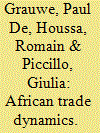

|
|
|
|
|
| Publication |
2012.
|
| Summary/Abstract |
This paper employs the standard gravity model to identify the quality of governance of China's African trade partners. As a benchmark, we perform the same analysis on other major African trade partners: France, Germany, UK, and USA. Data from 53 African countries in 1996-2009 show that only China is consistently willing to import more from African countries with a lower governance standing. By doing so; China fills a gap left open by the other major world economies, and might even play a key role in the future development of Africa.
|
|
|
|
|
|
|
|
|
|
|
|
|
|
|
|
| 5 |
ID:
185670


|
|
|
|
|
| Summary/Abstract |
The African Continental Free Trade Agreement, launched on January 1, 2021, will be Africa’s most ambitious united endeavor to assert financial oversight over the extractive resources sector—if it is fully implemented. The United States can act as a supportive partner, but what matters most is change from within Africa itself to finally realize pan-African visions of economic sovereignty.
|
|
|
|
|
|
|
|
|
|
|
|
|
|
|
|
| 6 |
ID:
066004
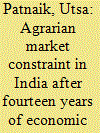

|
|
|
| 7 |
ID:
078034
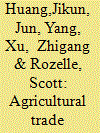

|
|
|
|
|
| Publication |
2007.
|
| Summary/Abstract |
The overall goal of this paper is to examine the impacts of trade liberalization on China's agriculture, in general, and poverty, in particular. The impacts on agriculture are analyzed by commodity and by region. Because different farmers (especially those in different income brackets) produce diverse sets of commodities, the main part of our paper analyzes the effects on households and their implications for the poverty through the simulation of household production and consumption changes in response to the trade-induced market prices changes on a disaggregated (by province), household-level basis. The results of our analysis lead to the conclusion that, unlike fears expressed in the popular press and by some scholars, the positive impacts of trade liberalization are actually greater than the negative ones. Although other effects on the rural economy from trade liberalization of other subsectors (such as textiles) may be equally large or even larger, this study's focus on the agricultural sector shows that there will be an impact from agricultural trade liberalization and that the net impact is positive for the average farm household in China. However, policymakers still need to be concerned. Not all households and not all commodities will be treated equally. Our findings show that poorer households, especially those in the provinces in the western parts of China, will be hurt. The main reason is that the farmers in Western China are currently producing commodities that are receiving positive rates of protection, rates of protection that will fall with additional trade liberalization. Hence, if policy makers want to minimize the impacts, there needs to be an effort to minimize the effect on these households either by direct assistance or by eliminating constraints that are keeping households from becoming more efficient by shifting their production more towards those commodities that will benefit from trade liberalization
|
|
|
|
|
|
|
|
|
|
|
|
|
|
|
|
| 8 |
ID:
145702
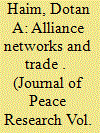

|
|
|
|
|
| Summary/Abstract |
How does the network of international political alliances influence trade flows? Previous work suggests that alliances matter in predicting trade outcomes because governments align trade policies with national security interests and firms take political relations between states into account when assessing risk. However, work to date investigates only the relationship between direct political alliances and trade, which ignores the complexity of international alliance structures. In this article, I argue that states and firms not only consider direct political relationships when shaping international trade, but also focus crucially on indirect alliance relationships. I find that higher levels of trade result when states have more shared alliances and when they are in the same alliance community. Once these indirect relationships are accounted for, the apparent association of dyadic alliances with trade is drastically reduced. Joint membership in an alliance community predicts an increase in trade that is more than twice the increase associated with a dyadic alliance. This effect is magnified when considering highly ‘central’ states in the alliance network. States trade significantly more with central states in their own alliance community and less with central states in other communities.
|
|
|
|
|
|
|
|
|
|
|
|
|
|
|
|
| 9 |
ID:
178571


|
|
|
|
|
| Summary/Abstract |
The era of American leadership in the multilateral trading regime has ended. This paper argues that this current antipathy to trade is unsurprising: support for US leadership of the regime has always rested on a precarious balance among domestic interests. To overcome a historic bias in favor of home market production, American leaders created incentives for exporters to organize while creating roadblocks for import-competing firms and their employees. The dominance of the exporters’ voice had a significant influence on the policies the US pursued in the design and execution of the global trade regime. Most importantly, the absence of labor's voice undermined the prospect for “embedded liberalism” and instead resulted in an anemic system of adjustment for job loss at home and limited support for worker interests within the regime. While policymakers’ decision to shift power away from potential “veto” groups may have been necessary for US leadership of the Liberal International Order, this institutional design undermined a robust response to the economic dislocation thought to be a result of globalization. The result was a fracturing of the coalition in support of American leadership in the GATT/WTO regime.
|
|
|
|
|
|
|
|
|
|
|
|
|
|
|
|
| 10 |
ID:
129969
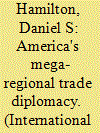

|
|
|
|
|
| Publication |
2014.
|
| Summary/Abstract |
The United States is currently negotiating two massive regional economic agreements, one with 11 Asian and Pacific Rim countries and the other with the 28-member European Union. The Trans-Pacific Partnership (TPP) and the Transatlantic Trade and Investment Partnership (TTIP) herald a substantial shift in US foreign economic policy as Washington turns its focus from the stalemated Doha Round of multilateral trade negotiations and scattered bilateral trade agreements to 'mega-regional' trade diplomacy. As the only party to both negotiations, Washington seeks to leverage issues in one to advance its interests in the other, while reinvigorating US global leadership.
|
|
|
|
|
|
|
|
|
|
|
|
|
|
|
|
| 11 |
ID:
073331
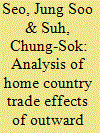

|
|
|
|
|
| Publication |
2006.
|
| Summary/Abstract |
A debate surrounds the trade impact of outward foreign direct investment (FDI), notably as to whether outward FDI complements or substitutes for a home countrys exports. This paper uses a fixed effect panel data econometric model to investigate the experience of Korean outward FDI in the ASEAN-4, during the 19872002 period. The results show that FDI stocks in ASEAN do not have discernable trade substituting effects on either Koreas exports or imports. However, it is found that contemporaneous FDI flows marginally contribute to Koreas exports to the region.
|
|
|
|
|
|
|
|
|
|
|
|
|
|
|
|
| 12 |
ID:
066838
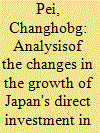

|
|
|
| 13 |
ID:
170546
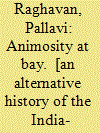

|
|
|
|
|
| Publication |
Noida, HarperCollins Publishers, 2020.
|
| Description |
xii, 247p.hbk
|
| Standard Number |
9789353572730
|
|
|
|
|
|
|
|
|
|
|
|
Copies: C:1/I:0,R:0,Q:0
Circulation
| Accession# | Call# | Current Location | Status | Policy | Location |
| 059832 | 327.54091/RAG 059832 | Main | On Shelf | General | |
|
|
|
|
| 14 |
ID:
191150
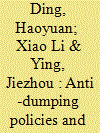

|
|
|
|
|
| Summary/Abstract |
Anti-dumping policies, as one of the most important nontariff measures to protect a country's economic interests, can have an impact not only on a country's trade and social welfare, but also on capital flows. Anti-dumping measures can result in increased trade costs and alterations to exchange rate risk. This study investigates the impact of anti-dumping sanctions on the international portfolio allocations of global funds. Antidumping policies can decrease the proportion of a fund's investment portfolio allocated to recently-sanctioned countries. Closer trade ties between the sanctioned country and the country where a fund is domiciled exacerbate the divestiture, but stronger foreign direct investment links weaken the negative association. Some country and fund heterogeneities are also discussed. We find that more developed countries are less affected by the impact of anti-dumping measures on equity fund allocations; liberalization of the economy and stable government could also mitigate the negative impact of anti-dumping sanctions. High-risk funds, such as growth funds or funds that invest in leveraged buyouts, showed the greatest response to changes in anti-dumping regulations.
|
|
|
|
|
|
|
|
|
|
|
|
|
|
|
|
| 15 |
ID:
136064
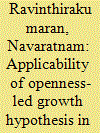

|
|
|
|
|
| Summary/Abstract |
An openness-led growth hypothesis investigates the causal relationship between trade openness1 and economic growth. Indeed, trade openness can stimulate economic growth by enhancing the international flow of knowledge and innovation and by allowing economies of specialization, not only in the production of goods, but also in the generation of new knowledge and new inputs into production. The purpose of this article is to empirically examine an openness-led growth hypothesis, using the case of Sri Lanka for the period from 1965 to 2012. The article uses the recently developed autoregressive distributed lag (ARDL) bounds test for cointegration developed by Pesaran et al. (2001). The empirical results confirm the validity of the openness-led growth hypothesis for Sri Lanka.
|
|
|
|
|
|
|
|
|
|
|
|
|
|
|
|
| 16 |
ID:
120718


|
|
|
|
|
| Publication |
2013.
|
| Summary/Abstract |
Abstract Not only is the participation of developing countries in international trade negotiations growing, so is their influence over the global trade agenda. This article highlights the increasing activism and impact of African states through a detailed study of the current Economic Partnership Agreement (EPAs) negotiations with the European Union (EU). In examining African resistance to EPAs, the article develops a constructivist approach to North-South trade negotiations that pays close attention to the role of development discourses. We argue that the growing willingness of African states to challenge the EU to deliver on its development promises during the decade-long EPA process was crucial to informing their sustained opposition to the EU's goal of completing a comprehensive set of sub-regional economic agreements. We document African resistance to EU trade diplomacy in the EPAs, exploring how these otherwise weak countries were able to pursue normative-based negotiation strategies by recourse to the EU's promise of a 'development partnership.'
|
|
|
|
|
|
|
|
|
|
|
|
|
|
|
|
| 17 |
ID:
158307
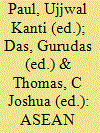

|
|
|
|
|
| Publication |
New Delhi, Pentagon Press, 2017.
|
| Description |
xix, 228p.: figures, mapshbk
|
| Standard Number |
9789386618023
|
|
|
|
|
|
|
|
|
|
|
|
Copies: C:1/I:0,R:0,Q:0
Circulation
| Accession# | Call# | Current Location | Status | Policy | Location |
| 059356 | 382.095405/PAU 059356 | Main | On Shelf | General | |
|
|
|
|
| 18 |
ID:
098100
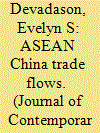

|
|
|
|
|
| Publication |
2010.
|
| Summary/Abstract |
There are claims that China's influence on ASEAN is direct in that she has encouraged more exports to flow into her huge markets and changed trade flows amongst member countries. Demand and supply are deemed to have therefore become more China-centred. This paper looks at the plausibility of China as a 'factor' that influences bilateral intra-ASEAN trade flows through demand (exporting country) and supply (partner country). The key finding of the study is that China's trade association with the region increases intra-ASEAN exports. China is therefore the most practical choice for the ASEAN+1 FTA to initiate deeper trade integration within the region. China, as the 'core' country of the ACFTA can provide complementarities in the export performance of ASEAN.
|
|
|
|
|
|
|
|
|
|
|
|
|
|
|
|
| 19 |
ID:
141994
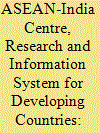

|
|
|
|
|
| Publication |
New Delhi, Routlege, 2015.
|
| Description |
xliii, 143p.: ill., figures, tables, mapspbk
|
| Standard Number |
9781138653481
|
|
|
|
|
|
|
|
|
|
|
|
Copies: C:1/I:0,R:0,Q:0
Circulation
| Accession# | Call# | Current Location | Status | Policy | Location |
| 058375 | 341.2473054/ASE 058375 | Main | On Shelf | General | |
|
|
|
|
| 20 |
ID:
078455
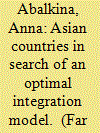

|
|
|
|
|
|
|
|